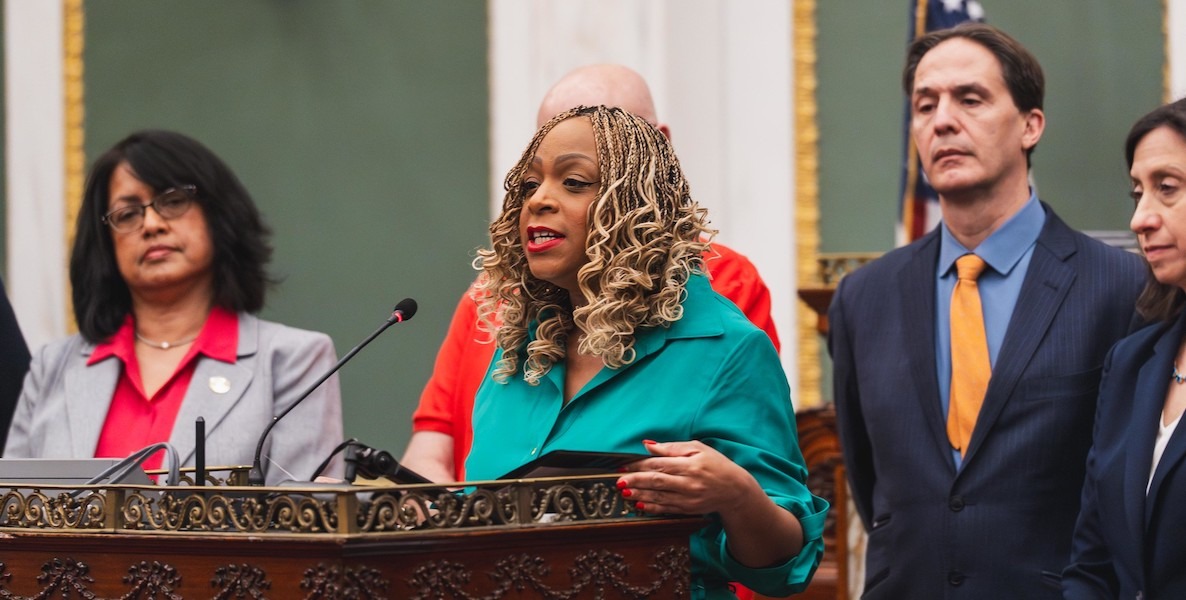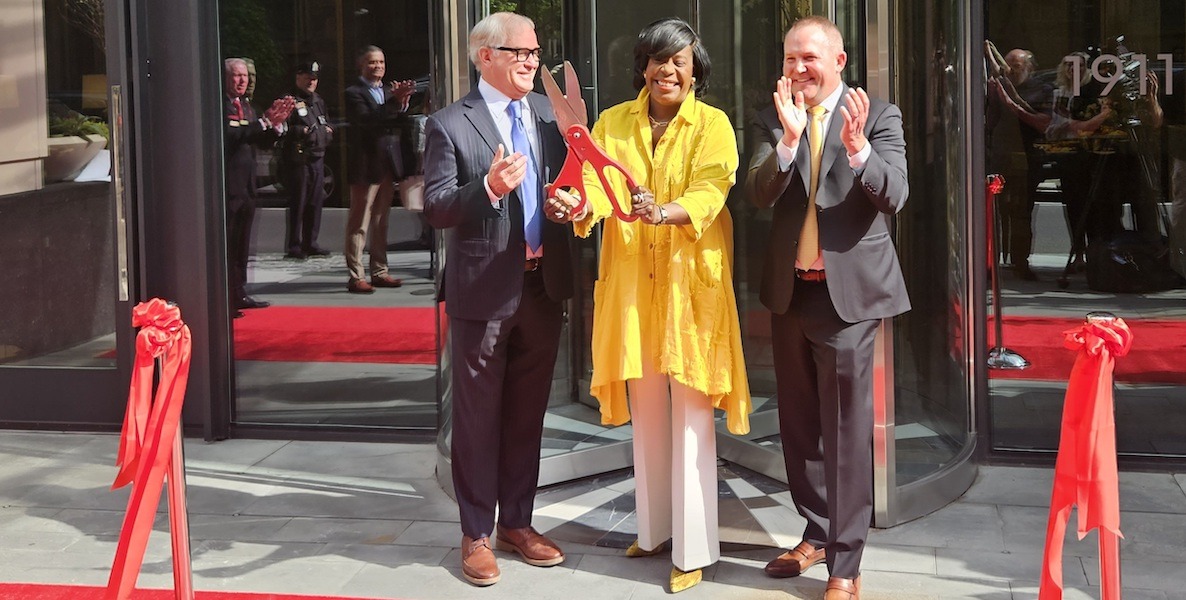There’s a certain brilliance to Mayor Cherelle Parker’s Mission 30,000 initiative as a political focal point for Philadelphia’s housing debates.
During the 2023 Mayoral campaign, then-Councilmember Parker pledged to preside over the creation and preservation of 30,000 homes during her term, one of the main measurable goals she outlined before winning the election. Now into the second year of the administration, the Mayor is ramping up these efforts, exploring legislative and administrative changes to reduce time and uncertainty costs in the housing development process, along with new yet-to-be-announced funding commitments for affordable housing and home repairs.
While the Parker administration has received criticism from some corners for staying light on policy details at this juncture, the goal itself has already done some useful political work by reorienting a lot of government and non-governmental actors in City Council, housing agencies, builders and affordable housing policy groups around a big audacious production goal, and challenging them to come with their best ideas for increasing the city’s housing supply.
The Mayor has essentially handed City Council and other actors a blank coloring book that they can color in with their favorite shades of housing policy, as long as they stay in the lines.
The Mayor has essentially handed City Council and other actors a blank coloring book that they can color in with their favorite shades of housing policy, as long as they stay in the lines — the values spelled out at the Mission 30,000 executive order signing on February 19. These include preserving existing homes and increasing stability for people, building more housing, making housing more affordable, and making the City’s processes work better for the people engaging with them.
That order created an ad hoc multi-disciplinary advisory group called H.O.M.E. which is tasked with preparing a plan to broadly reduce red tape in the housing approval process within 30 days. That group includes representatives from city and state housing agencies, developers, the building trades, nonprofit housing developers, and others with housing development and financial knowledge.
Thirty days is an ambitious turnaround window, but it’s also the case that most local housing watchers could probably draw up a list of the most significant housing blockers in a single afternoon. The issue isn’t that the problems are unknown: It’s that there’s often a political constituency for the dysfunction, namely City Council members who are overly deferential to homeowner groups trying to suppress more infill housing.
Councilmember Gauthier kicks it off
Two recent bills introduced by 3rd District Councilmember Jamie Gauthier are illustrative of the dynamics in play. Those bills would create a faster review timelines and approval deadlines for certain kinds of affordable housing projects in the city’s approval pipeline, and create more opportunities for homeowners to add accessory dwelling units (or ADUs, in planner speak) to their properties, which Gauthier is branding as “bonus units.”

Gauthier deserves a lot of praise for starting to color in the 30,000 Homes coloring book first among her colleagues, and hopefully her initiative will spur some friendly competition on Council by encouraging other members to introduce housing supply legislation of their own. Legislation that directly legalizes certain housing types in this way is exactly what the situation calls for. The administration may have their own priorities, based on the advisory group’s eventual recommendations, but every little bit helps as long as the ideas are additive.
Some of the details of the accessory dwellings bill illustrate the political headwinds for the Mayor’s housing goals as these debates move to City Council.
For starters, the bill would only apply to the four City Council districts where accessory dwellings are already allowed, albeit in very constrained use cases. Meanwhile, the Northwest and Northeast Council districts, featuring more of the suburban-style character where ADUs typically make the most sense as a housing type, have effectively banned them.
ADUs are considered a fairly modest housing reform to begin with, and aren’t expected to yield very large amounts of new housing even under a very expansive policy. That’s why they’re typically seen as political low-hanging fruit by zoning reformers. Even so, this housing type has faced determined resistance in the past from some Councilmembers.
Successfully reaching the 30,000 homes goal will require more City Council members to buy into the Mayor’s vision by changing their approach, which too often featured knee-jerk opposition to apartment buildings and more affordable small-lot multifamily housing choices.
During the heyday of Philadelphia’s Zoning Code Commission, which resulted in the passage of a significant zoning reform package in 2012, ADUs were adopted into the city’s code for the first time. But Council never mapped them to any of the zoning categories on the books, so for a long time they remained a stranded piece of code, levitating in planning limbo with no possible use cases.
Worse still, Philly’s ADU ordinance also contains numerous known poison pills that stand in the way of property owners and builders realistically being able to finance and construct these homes. There’s an owner-occupancy requirement for the principal dwelling — a known financing killer based on other cities’ and states’ experiences — and the code also doesn’t allow for new-construction ADUs, only rehabs of existing buildings. In districts with minimum parking requirements, the ADU would also be required to have its own parking space, creating an often-insurmountable cost and space hurdle.
There was some limited progress in expanding the terms of the ADU ordinance back in 2019, when City Council passed a package of changes designed to make the reuse of historically-designated properties more feasible. That law allowed historically-designated properties to add an ADU by-right, but only for rehabs of existing structures, not brand new ADUs. The owners of the famous “Mother’s House” from architect Robert Venturi in Chestnut Hill were denied by the Zoning Board of Adjustment when they pursued a variance to create a new ADU on their property, and it’s unclear whether anyone else has tried to make use of the provision for historic properties.
In 2021, the Planning Commission under Mayor Kenney proposed an extremely modest ADU reform as part of a broader code clean-up bill, allowing homeowners to build an ADU if their lot is over 1,600 square feet. The wonky context is that the zoning code already allows residential property owners to legally split a 1,600 square-foot lot into two 800 square-foot lots and build two homes, so this change would have simply cut out the lot-split step.
That led to a minor freak-out on Council that ended with two districts (the 6th and 10th) abusing the zoning overlay tool to ban ADUs districtwide, and four others (the 4th, 5th, 8th and 9th) nullifying only the lot-split change throughout their districts. That’s why Councilmember Gauthier’s recent ADU bill would only apply to the 1st, 2nd, 3rd and 7th Council Districts.
This makes sense as a concession to political reality, from the standpoint of wanting to pass a bill in the short-term, but it’s an awfully silly way to plan our city. That’s no slight to Councilmember Gauthier, who’s been more outspoken than most about zoning-related issues outside of the 3rd District. It calls into question, though, whether it’s even possible to still pass citywide housing laws in Philadelphia, when some number of members can always just nullify those changes in their districts right away.
The ADU saga is just one example of many. A quick search of City Council’s Legistar website turns up 150 such zoning overlays — special zoning rules on top of the existing base zoning — that Councilmembers enacted since 2013, the year after City Council passed the Zoning Code Commission’s overhaul of the code. Among the other changes made in that package, the ZCC’s reforms were designed to clear away many of the old overlay districts and simplify the rules citywide. According to local commercial real estate broker and long-time zoning watcher Dennis Carlisle, this has reduced the land area where the base zoning code is the only zoning code to less than 25 percent.
As I’ve previously observed, there are now 10 different sets of rules for building a simple rowhouse depending on which Council district you’re in. To make real progress toward the Mayor’s goal, we need to regain the ability to pass citywide planning legislation and clear away more of this overgrown regulatory underbrush.
At the Mission 30,000 announcement press conference, Mayor Parker noted the tension between councilmanic prerogative — the unwritten tradition of District members deferring to one another on land use questions in their home districts — and the administration’s efforts to increase the rate of home-building. Mayor Parker offered reassurance that, as a former 9th District Councilmember, the prerogative tradition is not in her crosshairs.
In reality, there’s no alternative to working with City Council to pass zoning ordinance changes, as there’s a limited scope for the Mayor to act unilaterally to advance the kinds of changes that would make a meaningful difference for the rate of home-building. But successfully reaching the 30,000 homes goal will require more City Council members, and especially District members, to buy into the Mayor’s vision by changing their approach from the Nutter and Kenney years, which too often featured knee-jerk opposition to apartment buildings and more affordable small-lot multifamily housing choices like duplexes and triplexes.
The whole-of-government approach Mayor Parker called for will require a more constructive approach from City Council if this initiative is to have any chance of succeeding, and Councilmember Gauthier’s bills help light the way forward.
![]()
MORE HOUSING IDEAS FROM THE PHILADELPHIA CITIZEN
Mayor Cherelle Parker, at the ribbon cutting for the luxury high-rise condos The Laurel on Rittenhouse Square.


